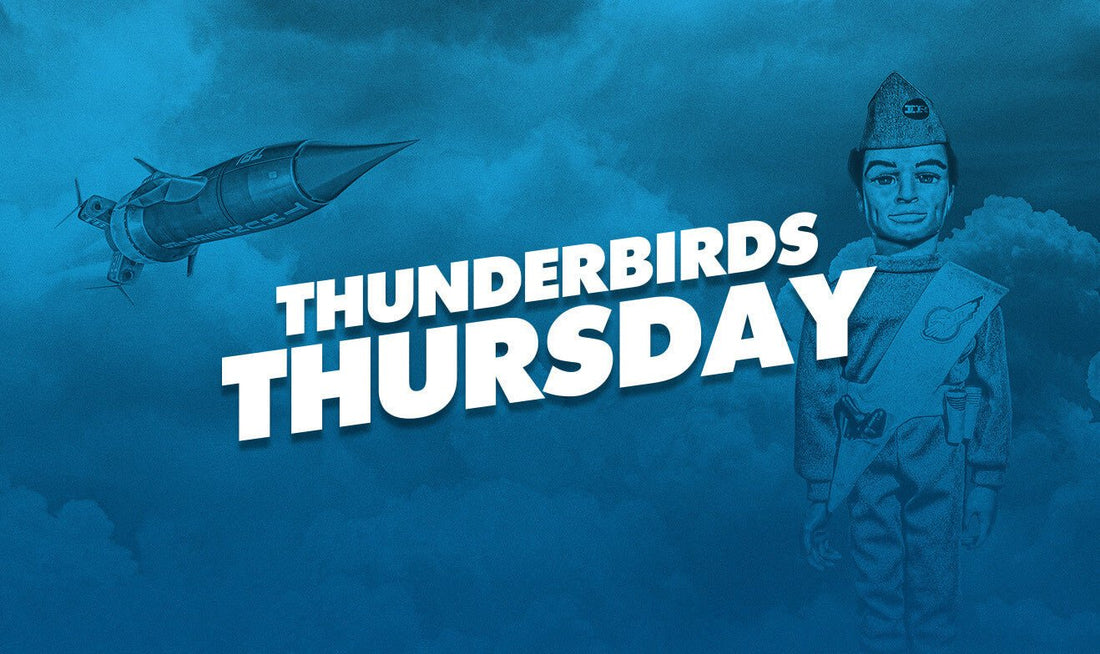Thunderbirds Thursday: Thunderbirds' Extended Comics Universe

It's rare for a Gerry Anderson TV series to have lasted more than two series. Supercar, Thunderbirds, Space: 1999 and Terrahawks are some of the notable exceptions that managed to stretch beyond one season's worth of material, but all of Gerry's other productions only ever lasted a brief lifetime on the small screen. However, each series was regularly accompanied by vast swathes of merchandise, including additional stories told through comics, novels, annuals, and more.
This Thunderbirds Thursday, we're blasting off on a whistlestop tour of Thunderbirds' extended universe through its spin-off comics!
TV Century 21 is Go!

Thunderbirds has enjoyed a bountiful amount of comic spin-offs since the 1960s. In fact, Thunderbirds was technically a comic strip before it was a TV series. Seven months before the TV series' debut in September 1965, the advent of TV Century 21 (later shortened to just TV21) included a comic strip prequel for Lady Penelope and Parker, showcasing their adventures as a pair of undercover trouble-shooters prior to joining International Rescue. The Lady Penelope strip was retired when Thunderbirds blasted off in the comic's pages in January 1966. Between 1966 and the comic's end in September 1969, Thunderbirds became one of TV Century 21's core mainstays, running for 39 adventures across nearly four years.
Thunderbirds' TV21 adventures were chiefly illustrated by artist Frank Bellamy, who drew Thunderbirds with a hugely dramatic flourish that enabled Thunderbirds to easily become one of TV21's greatest efforts. Bellamy's artistic take on Thunderbirds merged fantastically eye-catching angles of the Thunderbird craft in action with dynamic page compositions. Bellamy's only time away from being the strip's resident artist came during the epic Solar Danger storyline, with fellow ex-Eagle artist Don Harley temporarily filling in. Thunderbirds' TV21 adventures began as a faithful expansion of their television counterpart and saw International Rescue battle against such threats as sun-induced environmental disasters, runaway wildlife, and politically charged revolutions. The strip would take a wilder turn from roughly the middle of its run, pushing Thunderbirds into more outlandish territory as International Rescue's threats ranged from killer robot penguins to time-travelling dam busters.
Lady Penelope was mostly absent from TV21's Thunderbirds strip, with she and Parker only ever making a skeletal set of appearances. However, this was compensated with the launch of her ladyship's own self-titled comic, which carried on her spy-fi adventures. Lady Penelope's own strip was chiefly illustrated in spectacularly lavish style by Frank Langford, but also received contributions from Michael Strand and John Burns. The Lady Penelope comic itself was shortened to be named just Penelope in 1968, and with this change, the Lady Penelope strip shifted focus to featuring a much younger Penelope, with the strip now retitled Stories of When Penelope Was Just a Girl. The strip underwent even further changes when Penelope merged with Princess Tina, with the strip now focusing on a teenage 'Penny Ward' embracing life in swinging 60s London.

TV21 editor-in-chief Alan Fennell was the main writer of the comic's Lady Penelope prequel and is generally accepted to have been the main writer on TV21's Thunderbirds strip for roughly the first two years of its run. Prolific boys' action comics freelancer Scott Goodall is often credited with taking over from Fennell in writing TV21's Thunderbirds, while Fennell himself still wrote for Lady Penelope when her adventures transferred over into her own comic.
Countdown to Fleetway
Thunderbirds was one of the few Anderson properties to make the leap when TV21 merged with Joe 90: Top Secret to become TV21 & Joe 90. With issue numbering starting afresh, this soft reboot saw Bellamy only illustrate the debut story, Seeking Disaster. John Cooper would take over as the artist on the comic's Thunderbirds strip. However, the Thunderbirds strip was wound down after several adventures in June 1970.
Thunderbirds, along with most of Gerry and Sylvia's other 1960s puppet creations, would receive a new lease of life with the arrival of Countdown in 1971. Edited by former TV21 art editor Dennis Hooper and published by Polystyle Publications, both Thunderbirds and Lady Penelope would enjoy a fresh outing of adventures, albeit in black and white. Countdown's Thunderbirds strip was chiefly illustrated by Don Harley, while both Frank Langford and Michael Strand would return to illustrate the three standalone Lady Penelope stories published in the comic's early issues. Original adventures gradually wound down, possibly as a result of Countdown's slim in-house staff, and instead Countdown grew to rely on reprints of classic TV21 adventures.

Further comic strip adventures for Thunderbirds would be absent until the 1990s. Fleetway's Thunderbirds the Comic was published to accompany the series' BBC revival and became a runaway and long-lasting hit between 1991 and 1993. As well as reprinting TV21 material, the comic included episode adaptations and original storylines, which were illustrated by a mixture of new and returning artists. These adventures threw International Rescue into 1990s technology, and some even acted as sequels to TV episodes, most notably Return of the Zombites, in which the Zombites from The Uninvited join forces with the Hood. Fans could also enjoy the colossal multi-media serial The Complete Thunderbirds Story, illustrated by Steve Kyte and Andrew Skilleter and written by Alan Fennell. This lengthy epic brought the story of International Rescue's formation to life in a uniquely thrilling way through comic strips, prose, and other illustrations.
Further original comic strips could be found in The Funday Times, but Thunderbirds' next major comic revival came in Redan's Thunderbirds comic, which ran for a staggering seven years between November 2000 and December 2007, publishing within Thunderbirds' late 1990s revival and continuing into the series' 40th anniversary in 2005. The comic initially ran until early 2005, when it underwent a rebrand to tie into the series' 40th anniversary celebrations, running just shy of 90 issues overall. Much of the comic's original storylines were targeted at perhaps a younger demographic than the darker TV21-era material. They were chiefly illustrated by fan-turned-professional artist Lee Sullivan. These stories still carried some uniqueness to them, with crossover appearances from the World Aquanaut Security Patrol and the lesser-seen Federal Agent Bureau!
Specials & Annuals

Thunderbirds' comic strip adventures only scratch the surface of International Rescue's extended universe. Aside from the serialised adventures in TV21, a variety of standalone comics and short text stories were regular staples of various comic specials, annuals, and storybooks throughout the 1960s. Between 1965 and 1967, seven TV21 specials came out of the growing Century 21 Publishing empire. Short stories told as comics and text stories were also regular staples of Gerry Anderson annuals. Five Thunderbirds annuals were produced between the late 1960s and early 1970s, along with several Lady Penelope annuals. Thunderbirds material was also a regular staple in the five TV21 annuals produced between 1965 and 1970, as well as two Countdown annuals from the early 1970s.
The comic strips featured in these annuals and specials featured varying artistic line-ups. The likes of Frank Bellamy, Mike Noble, and Ron Embleton generally didn't contribute to the annuals. Instead, Brian Lewis, Ron Turner, Don Harley, Frank Langford, and Michael Strand were regular contributors to Thunderbirds adventures in the TV21 specials, while regular TV21 alumni Rab Hamilton, Jon Davies, Malcolm Stokes, and Jim Watson contributed to Thunderbirds' annual adventures. Given that these annuals and specials came out of the same publishing empire as TV21, the likes of Alan Fennell and TV21 script editor Angus Allan were surely regular authors, meaning that these briefer stories weren't that far removed in style from the regular strips in TV21. This ensured that a tonal consistency was well-maintained throughout the growing sprawl of non-TV story material for Thunderbirds throughout the late 1960s.
The text stories made extensive use of uniquely thrilling publicity photographs of Thunderbirds vehicles and characters in action, which would rarely be used in other merchandise, making these short stories all the more noteworthy. These photos were generally taken by Century 21 Productions' in-house photographer Doug Luke, who commanded his own photo studio within the Slough studios, shooting a variety of imaginative scenarios for use in TV21 comics, annuals, and other publications. The annuals and specials also regularly featured in-universe features and essays that enhanced the world of Thunderbirds (and other Supermarionation heroes) through vehicle cross-sections, character biographies, and extensive written histories on other avenues of TV21's shared world, of which Thunderbirds was an integral part.
Thunderbirds' comic book adventures span an enjoyably eclectic range of scenarios, even though some avenues of stories may forget the core idea of International Rescue's main purpose: to be a rescue organisation! Across these comics from numerous decades, it wasn't uncommon to find International Rescue turn their attentions to battling supervillains and even grotesque space monsters.
Intriguingly, these comics also regularly showed how they weren't entirely tied down to the confines of the original TV series by often pushing International Rescue's technology to new heights. Whether it was witnessing Thunderbirds 1 and 2 take off into deep space or seeing new pod vehicles swing into action, the comic book worlds of Thunderbirds offer countless delightful highlights in taking the adventures of International Rescue in unexpected directions!
You'll be able to experience these classic publications and more up close as part of Anderson Entertainment's forthcoming concert, Stand By For Action! 2: Tunes of Danger. A collection of original comics, annuals, storybooks, and other classic Gerry Anderson merchandise will be on display in our From The Archives exhibition. This exciting collection will be on display as part of our Gerry Anderson musical extravaganza, which promises to be a night to remember for all Anderfans!

Stand By For Action! 2 Tunes of Danger takes place on the 13th of July at Birmingham Symphony Hall. Tickets for the concert remain on sale, so be sure to grab your tickets for a spectacular evening of music, nostalgia, and adventure!
To be the first to hear about the latest news, exclusive releases and show announcements, sign up to the Anderson Entertainment newsletter!




![Thunderbirds Comic Anthology Volume One [HARDCOVER] - The Gerry Anderson Store](http://gerryanderson.com/cdn/shop/files/thunderbirds-comic-anthology-volume-one-hardcover-8030771.jpg?v=1751089031&width=720)
![All Sections Alpha: The Making of Space: 1999 [HARDCOVER] - The Gerry Anderson Store](http://gerryanderson.com/cdn/shop/files/all-sections-alpha-the-making-of-space-1999-hardcover-7498116.png?v=1757766647&width=720)

![Stingray Comic Anthology Volume Two – Battle Lines [HARDCOVER] - The Gerry Anderson Store](http://gerryanderson.com/cdn/shop/files/stingray-comic-anthology-volume-two-battle-lines-hardcover-107681.jpg?v=1738856151&width=720)
![Stingray W.A.S.P. Technical Operations Manual Standard Edition [HARDCOVER] - The Gerry Anderson Store](http://gerryanderson.com/cdn/shop/files/stingray-wasp-technical-operations-manual-standard-edition-hardcover-112278.jpg?v=1749664163&width=720)
![Stingray WASP Technical Operations Manual Special Limited Edition [HARDCOVER BOOK] - The Gerry Anderson Store](http://gerryanderson.com/cdn/shop/files/stingray-wasp-technical-operations-manual-special-limited-edition-hardcover-book-991914.jpg?v=1749657538&width=720)
![Stingray: The Titanican Stratagem – Signed Limited Edition [HARDCOVER NOVEL] - The Gerry Anderson Store](http://gerryanderson.com/cdn/shop/files/stingray-the-titanican-stratagem-signed-limited-edition-hardcover-novel-129251.jpg?v=1740558711&width=720)







